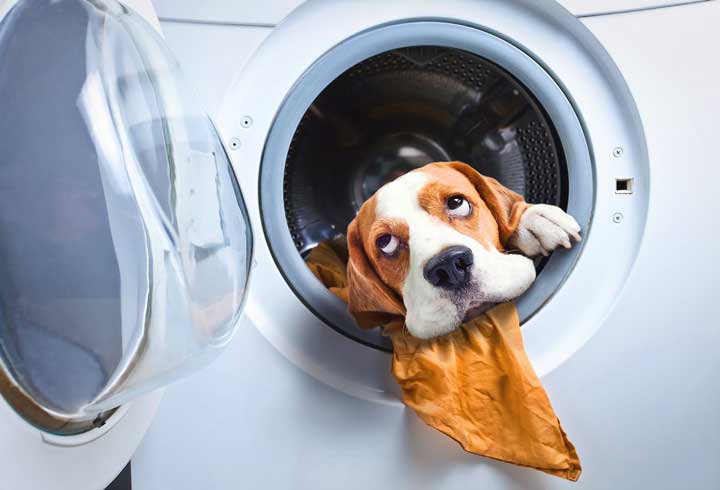 The washing machine hums when working and makes sounds - it is normal.
The washing machine hums when working and makes sounds - it is normal.
But, if there appeared a loud noise, then there is a reason to think about the serviceability of some parts of the equipment.
It will be necessary to analyze uncharacteristic noises and diagnose the washing machine.
Noise inside noise limits
The norm can be different and depends on the appliance and the drive option:
- belt varies from 60 to 72 dB;
- direct from 52 to 70 dB.
These decibel levels are not silent, but they are not uncomfortable for users. So how do you know how loud a machine is?
An accurate measurement is possible with a noise meter. There are Chinese models, which are quite inexpensive. But it is not always possible to buy this equipment. What to do?
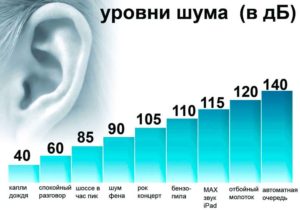 There are many associations with strength in dB. For example, a sound of 50 dB is characteristic of a typewriter, and 95 dB is the sound of a train on the subway. A jackhammer works at 120 dB of noise. You can be guided by these figures. If there is a feeling that the washing machine buzzes a lot and somehow strange noise, it is worth finding the causes and fixing the problem.
There are many associations with strength in dB. For example, a sound of 50 dB is characteristic of a typewriter, and 95 dB is the sound of a train on the subway. A jackhammer works at 120 dB of noise. You can be guided by these figures. If there is a feeling that the washing machine buzzes a lot and somehow strange noise, it is worth finding the causes and fixing the problem.
Causes of loud operation of the washing machine
Noise due to improper installation
In this case, the washing machine began to hum already at the first start of washing. What to do?
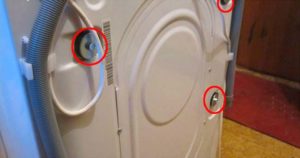 Check transport screws available. They should not be there! Often beginners do not know about them, but they can damage the washing machine. They are located on the back and fix the drum when moving. During the installation of the machine, the bolts should be removed, and plugs are installed in their place.
Check transport screws available. They should not be there! Often beginners do not know about them, but they can damage the washing machine. They are located on the back and fix the drum when moving. During the installation of the machine, the bolts should be removed, and plugs are installed in their place.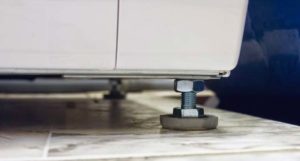 Provide the washing machine a level horizontal surface.
Provide the washing machine a level horizontal surface.- Adjust the feet so that the machine is given stability and does not wobble from side to side.
Noise due to malfunction
- on the tank (will definitely need to be replaced);
- in the housing.
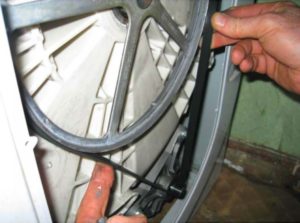 Weak attachment of the drum pulley. Such a failure is characterized by gusty clicks. The drum over time completely unbalanced. The solution to the problem is not complicated. To do this, remove the back cover and fasten the part, it is better if the bolt is planted on the sealant. This prevents it from loosening again.
Weak attachment of the drum pulley. Such a failure is characterized by gusty clicks. The drum over time completely unbalanced. The solution to the problem is not complicated. To do this, remove the back cover and fasten the part, it is better if the bolt is planted on the sealant. This prevents it from loosening again.- Loose bolts on engine backlash. It will be necessary to reinforce them.
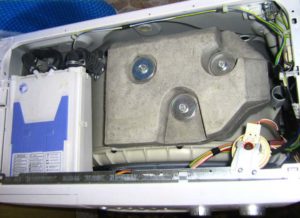 Weak counterweight and top springs mounts .. Counterweight is needed for tank stability in "spin". Their weight is chosen to balance the tank on both sides. They are located in a hard-to-reach place. To check the part for serviceability you need a flashlight and your hands. You will have to feel the bolts and check if they are loose or not. If the counterweights themselves are broken, you will have to replace them.
Weak counterweight and top springs mounts .. Counterweight is needed for tank stability in "spin". Their weight is chosen to balance the tank on both sides. They are located in a hard-to-reach place. To check the part for serviceability you need a flashlight and your hands. You will have to feel the bolts and check if they are loose or not. If the counterweights themselves are broken, you will have to replace them.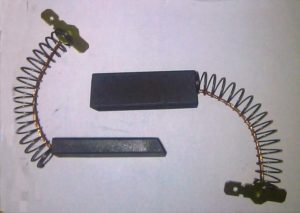 Worn out brushes. In this case, the washing machine hums, but does not spin the drum. This is accompanied by a very loud knocking sound. Brushes can not be repaired, only replaced. But to get to them, you will have to disassemble the entire engine.
Worn out brushes. In this case, the washing machine hums, but does not spin the drum. This is accompanied by a very loud knocking sound. Brushes can not be repaired, only replaced. But to get to them, you will have to disassemble the entire engine.- Trouble with the bearings. If the washing machine hums, rattles and makes a lot of noise, there may be a breakdown bearings. This is easy to check. It is enough to turn the drum with the machine off and listen. If it is quiet, it is not the problem. If you hear a rattle, then:
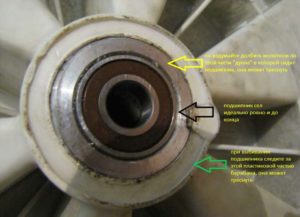 The front cover, bottom cover and control panel are removed.
The front cover, bottom cover and control panel are removed.- The back wall is also removed.
- Pulls out the heating element (heater) and the motor behind it, when removing which do not forget to move the belt.
- Disconnect the tank.
- Disassembles the tank.
- Worn or damaged bearings are knocked out and replaced with new, serviceable ones.
- Reassemble in the reverse direction.
The tank is sealed by the oil seals. They are often subject to wear and aging. And if the packing leaks moisture, it gets into the bearing and destroys it.
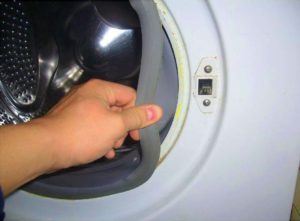 Interference with the oil seals. Due to the wrong size. A situation happens when cuff machine rubs against the drum and because of this there are rubber crumbs on the hatch. This is often a problem of economy class washing machine models. To correct the situation, you need:
Interference with the oil seals. Due to the wrong size. A situation happens when cuff machine rubs against the drum and because of this there are rubber crumbs on the hatch. This is often a problem of economy class washing machine models. To correct the situation, you need:
- Take sandpaper (not coarse) and tape it to the edge of the drum.
- The "spin" program is turned on.
- Then the rinse is started.
In this way, the sandpaper will clean the places of contact with the tank, and the rinse will clean the technique of rubber dust.
- Foreign Objects. If a foreign object gets into the drain pump, an inconstant loud crackle occurs.
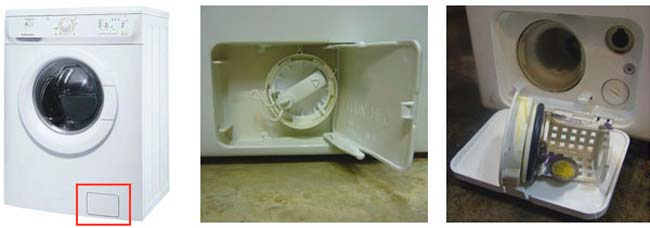
And at low speeds you can not hear it, but with strong vibration you hear whistling, creaking, etc. Why does the washing machine hum? What can interfere with its work? It can be buttons, paper clips, pins, coins, pins from the bra and others. To get them out, you have to pull out the heat and use a pair of tweezers to get the things out of the way. Be sure to lubricate the rubber with liquid soap when you put the heater back in.
Drain Pump can wear out in as little as 5 years, and if small objects get into it, even faster.
Noise Prevention
Following and observing a few small rules will avoid noise malfunctions of the machine. All you need to do is:
- not shoving too much laundry;
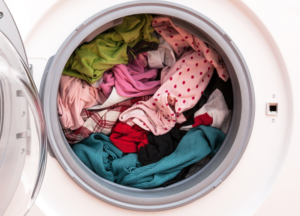
- do not start the wash several times in a row;
- do not often use the washing mode at a very high temperature;
- do not forget to clean the filter;
- do not allow the laundry to be started with foreign objects in the pockets;
- Do not use very hard water, if this is not possible, then be sure to soften it.

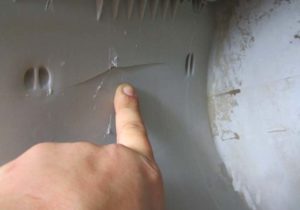
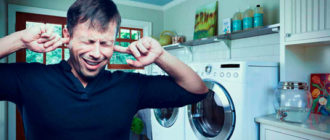
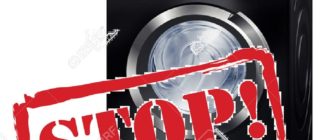

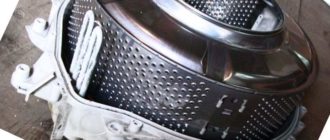
As a master of washing machine repair I can say that the article is interesting. Many possible causes are listed correctly. But everything is individual, so if you have a lot of noise, call a specialist.
